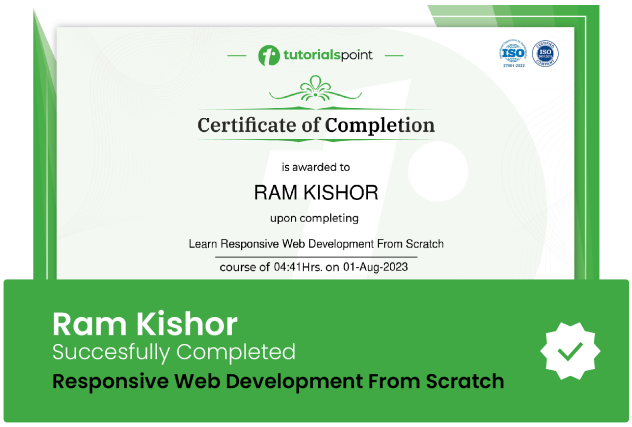How to Build a DITA XML Technical Writing Portfolio
How to Build a DITA XML Technical Writing Portfolio and demonstrate your skills in technical writing using DITA in Oxygen XML Author. You can get that job interview!

Lectures -27
Duration -1 hours

30-days Money-Back Guarantee
Get your team access to 10000+ top Tutorials Point courses anytime, anywhere.
Course Description
Do you wonder how you can demonstrate technical writing skills using DITA XML? Do you wonder how to make your resume (CV) shine compared to other technical writers' CVs and YOU get invited to the job interview?
As a technical writer, you want to demonstrate your DITA XML technical writing skills to impress the recruiting manager and get invited to the job interview.
If you are a student, who just wants to start in this field, I am sure you get frustrated every time you see in the job ads "3 to 5 years of experience wanted" or "provide technical writing examples from your previous work".
How can you possibly do that if you never get the job in the first place?! How can you start your journey and land the dreamed technical writer job in the software documentation development world, if they never give you a chance?
Well, my answer to that is simple - you need to design and develop your own technical writing portfolio. You must proactively approach it and focus on the skills you want to demonstrate to your desired employer.
In a world dominated by software development skills demand, you must know what to do to provide software documentation for the users!
My name is Jordan Stanchev. I've made my career in the field of technical communications with a strong focus on technical writing and information architecture, and writing using DITA XML over the last 20 years.
I practice what I teach as a part of a Fortune 500 company as a User Assistance Development Architect. I'm also one of the founders of the JPDocu School of Technical Writing where we help students like you learn the skills need to become successful technical writers.
In this course, I will show you the steps you should follow to:
- Prepare your DITA XML writing portfolio and
- Share it publicly to demonstrate your DITA XML technical writing abilities.
By the end of this course, you will be able to:
- strategically approach your technical writing project for any software app;
- organize your documentation structure in a DITA map;
- write the sequence of steps for the end-users using a DITA Task topic type;
- write the conceptual, background information for the end-user using a DITA Concept topic type;
- share your documentation sources in a GitHub repository;
- visualize your ready-to-be-published documentation for the end-user via GitHub.
This course is for you if you are a technical writer who wants to build a portfolio and use it to advance your career as a DITA technical writer in a corporation or as a freelancer.
To be able to successfully complete this course you must have at least a basic understanding of:
- technical writing
- structured writing
- what is DITA XML
If that is you, I welcome you to this course!
Who this course is for:
- Technical Writers Who Want to Demonstrate DITA XML Writing Skills in the Resume (CV)
Goals
What will you learn in this course:
- Strategically Approach Your Technical Writing Project For Any Software App
- Organize Your Documentation Structure In a DITA Map
- Write the Sequence of Steps For The End-Users Using a DITA Task Topic Type
- Write The Conceptual, Background Information For the End-user Using a DITA Concept Topic Type
- Share Your Documentation Sources In a GitHub Repository
- Visualize Your Ready to Publish Your Documentation For The End-user Via GitHub.
Prerequisites
What are the prerequisites for this course?
- Knowledge in Technical Writing Using DITA XML

Curriculum
Check out the detailed breakdown of what’s inside the course
How to Build a DITA XML Technical Writting Portfolio
27 Lectures
-
Introduction 02:41 02:41
-
Choose Your Tool for Writing 01:35 01:35
-
Installing a Tool for Writing with DITA 00:57 00:57
-
Installing Oxygen XML Author 01:03 01:03
-
What do you need to succeed 03:28 03:28
-
Project Goals 01:59 01:59
-
Assumptions and Limitations 03:18 03:18
-
Install Oxygen XML Author 00:32 00:32
-
Create a GitHub Repository 01:34 01:34
-
Project Plan - What Shall We Document 01:52 01:52
-
Project Plan - Phases of Writing 02:28 02:28
-
Phase 1 - Writing 04:48 04:48
-
Which are Task to Document 02:08 02:08
-
Sample Content - Writing the Steps of the Tasks 05:35 05:35
-
Demo - Create a DITA Task 08:49 08:49
-
Add Supporting Concepts 02:56 02:56
-
Sample Content - Writing a Supporting Concept 00:59 00:59
-
Demo - Create a DITA Concept 05:58 05:58
-
Phase 2 - Generate output 03:32 03:32
-
Pre-Production - Share Your DITA XML Source Files in the Repository 01:56 01:56
-
Demo - Upload DITA XML Source Files to GitHub Repository 03:05 03:05
-
Production - Generate Output from DITA XML 01:58 01:58
-
Demo - Generate PDF and HTML5 Output from DITA XML 05:10 05:10
-
Phase 3 - Share the Content With the End Users 01:35 01:35
-
Share Your PDF Output Using the Public GitHub Repository 02:56 02:56
-
Share Your HTML5 Output 05:22 05:22
-
Successful Completion of the Project 01:36 01:36
Instructor Details

Jordan Stanchev
eCourse Certificate
Use your certificate to make a career change or to advance in your current career.

Our students work
with the Best


































Related Video Courses
View MoreAnnual Membership
Become a valued member of Tutorials Point and enjoy unlimited access to our vast library of top-rated Video Courses
Subscribe now
Online Certifications
Master prominent technologies at full length and become a valued certified professional.
Explore Now



 Updated on Apr, 2024
Updated on Apr, 2024
 Language - English
Language - English